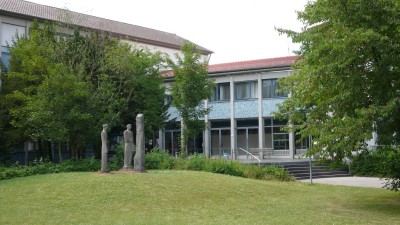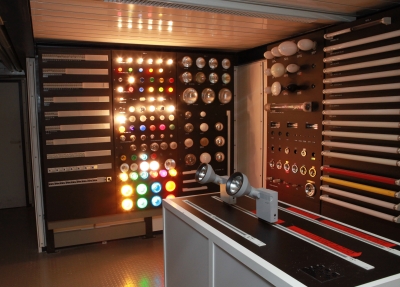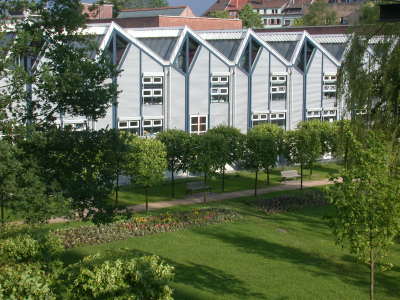Kaiserslautern on Facebook
On the official Facebook page of the city of Kaiserslautern, the press office posts relevant administrative topics but also other information about Kaiserslautern and life in the city.

The University of Applied Sciences in Kaiserslautern is a modern college of applied sciences and design. More than 5700 students from more than 80 nations and around 150 professors learn, teach and carry out research in five faculties at the campuses in Kaiserslautern, Pirmasens and Zweibrücken. Founded in 1996 as a spin-off from a department of the former Rhineland Palatinate University of Applied Sciences, the University, whose roots go back to the mid-19th century, used its independence to dedicate itself to its core tasks of degree-level teaching, advanced academic training and applied research and development with the associated transfer of technology, and to continue expanding its competitive position.

Verwaltungsgebäude der Hochschule © Hochschule Kaiserslautern
About 50 degree programmes are offered, which cover the areas of natural and engineering sciences, design, economics, information and communication sciences. Practical applicability and innovation, interdisciplinary work and flexibility, internationality but above all also regional associations – these are the trademarks of the courses, which were quickly converted to modern degree courses as part of the Bologna process.
With the further development of degree programs, new forms of studying, like the cooperative model of studying called KOSMO, and with the opening of the university for job-related qualified students, FH Kaiserslautern helps to secure the next gene
ration of qualified employees in the region. New large projects under financial support of the German ministry of education and research (BMBF) assure the quality of teaching and the crossover between job-related and academic education.

Lichtlabor © Hochschule Kaiserslautern
The joint research project Open Competence Region Western-Palatinate (OKW) “Offene Kompetenzregion Westpfalz” with emphasis on competence, promotes the installation and development of job and family related degree programs as well as the installation of an education network in the region.
Research and development at Kaiserslautern University of Applied Sciences is largely oriented on applicability, and is carried out almost exclusively in cooperation with companies. In this context, the University is available as a partner especially to local businesses, where the supervision of student work in the companies means that very many people are actively involved in the transfer of knowledge and technology. Active cooperation with the knowledge transfer network twin-rlp also opens up the potential of the other six universities of applied science in the Rhineland Palatinate.
A few years ago, the university set three applied focal points for its research: “Integrated Miniaturised Systems”, “Reliable Softwa
re-Intensive Systems” and “Sustainable and Ecological Products and Processes”.
The core competences of these focal points are microsystems technology and applied life sciences (a modern clean room with several process lines facilitates the development of micro and nanoparts), materials mechanics (investigations into internal stress), the development of systems in which software is closely allied with technical or organisational components, and the area of sustainable building and design.

Gebäude Bauen und Gestalten © Hochschule Kaiserslautern
These focal points have led to the creation of certain facilities which are available to businesses as partners for assignments or joint projects. The three most recent are mentioned here; for all others, please refer to the website under the rubric Research. The Bio Medical Engineering Competence Centre, founded in 2008 with financial support from the state, is the facility housing the expertise of the professors involved in the new course on Applied Life Sciences. Synergies from the areas of microsystems technology and nanotechnology, medicine and biology open up completely new diagnostic approaches, therapies and simulation possibilities. The core competence of the Institute of Sustainable Construction and Design is the integrative, energetic and technical optimisation of architectural planning and execution processes, taking the life cycle of buildings into account. The institute Plastics Technology Western-Palatinate (IKW) is a research and testing institute in the area of amplified and unamplified synthetic materials. It is partner for the execution of projects sponsored publicly and industrially along the value-added chain of plastic components. A platform for applied sciences around the topic „Energy efficiency“ shall offer the institute Energy Efficient Systems (IES) besides the course of studies of the same name.
Kaiserslautern University of Applied Sciences facilitates the exchange of students and professors with approximately 80 partner colleges around the world, thus guaranteeing the internationality of its courses.
Five departments:
• Applied Logistics and Polymer Sciences
• Building and Design
• Business Administration
• Engineering
• Computer Sciences / Microsystems Technology
with more than 50 degree programmes
Research Areas
• Micro- and Nanotechnologies
• Applied Life Sciences
• Materials
• Applied informatics
• Sustainable Construction and Design
Mehr Informationen finden Sie auf der gut aufgebauten Seite der Hochschule Kaiserslautern.